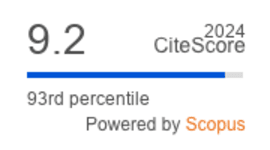Incidence, Antibiotic Susceptibility and Characterization of Vibrio parahaemolyticus Isolated from Seafood in Selangor, Malaysia
DOI:
https://doi.org/10.36877/pmmb.a0000233Abstract
Vibrio parahaemolyticus is one of the major foodborne pathogens owing to its cause of infectious diseases such as gastroenteritis. These diseases are often associated with the consumption of contaminated seafood. This study aims to investigate the presence of V. parahaemolyticus, their virulence, antibiotic profiles, and plasmid profiles from 77 different kinds of shellfish samples collected from wet markets and supermarkets in Selangor, Malaysia. High densities of Vibrio species ( > 5 log CFU/g) were found in 14/16 groups of shellfish. Among 77 presumptive V. parahaemolyticus isolates, 43 (55.8%) were positive for the toxR gene, confirming the identity of the isolates at the species level. However, none of the V. parahaemolyticus isolates harboured the virulence tdh and trh genes. The antibiotic susceptibility of the V. parahaemolyticus isolates revealed that most of them were resistant to ampicillin (95.3%), ampicillin-sulbactam (81.4%), cefotaxime (37.2%) and imipenem (23.3%). The plasmid profiles of the V. parahaemolyticus isolates showed that 41.9% (18/43) possess at least one plasmid. Our results indicate the V. parahaemolyticus isolates are continuously exposed to various antibiotics in the environments, thus consuming the seafood carries a potential health risk to consumers. The antibiotic resistance conferred by the species necessitates an immediate plan to approach the usage of antibiotics differently.
Downloads
Published
How to Cite
Issue
Section
License
Copyright (c) 2021 Vurmila Venggadasamy, Loh Teng-Hern Tan, Jodi Woan-Fei Law, Hooi-Leng Ser, Vengadesh Letchumanan, Priyia Pusparajah

This work is licensed under a Creative Commons Attribution-NonCommercial 4.0 International License.
Author(s) shall retain the copyright of their work and grant the Journal/Publisher right for the first publication with the work simultaneously licensed under:
Creative Commons Attribution-NonCommercial 4.0 International (CC BY-NC 4.0). This license allows for the copying, distribution and transmission of the work, provided the correct attribution of the original creator is stated. Adaptation and remixing are also permitted.

This broad license intends to facilitate free access to, as well as the unrestricted reuse of, original works of all types for non-commercial purposes.
The author(s) permits HH Publisher to publish this article that has not been submitted elsewhere.



.png)

.jpg)
